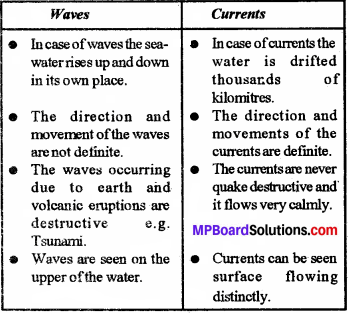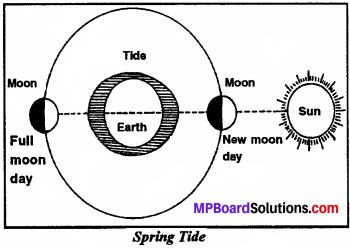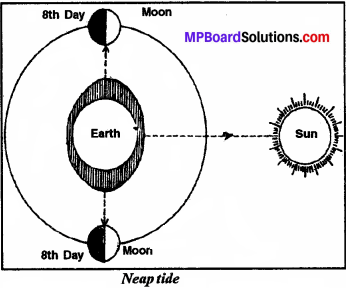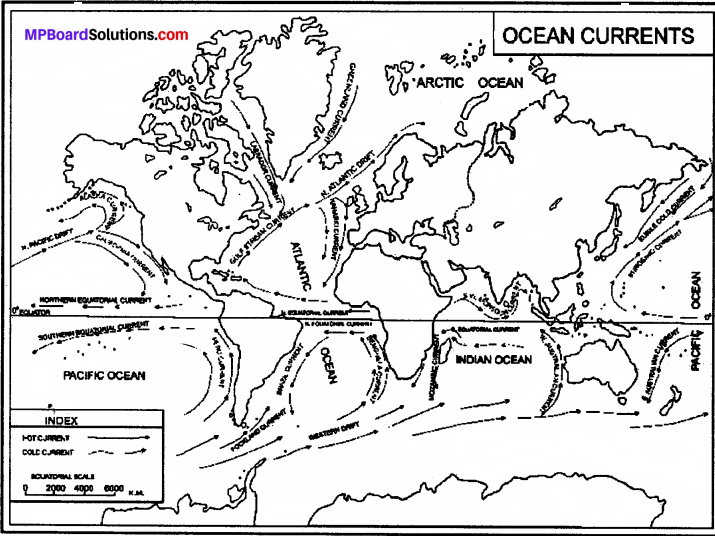MP Board Class 7th Social Science Solutions Chapter 21 Sea Movements
MP Board Class 7th Social Science Chapter 21 Text Book Questions
Choose the correct alternatives from the following
Class 7 Social Science Chapter 21 MP Board Question 1.
Waves occur due to:
(a) Rotation of die earth
(b) Tides
(c) Wind
(d) Difference in temperature
Answer:
(c) Wind
Mp Board Class 7th Social Science Chapter 21 Question 2.
Neap tide occurs on:
(a) 8th day
(b) Ml moon day
(c) new moon day
(d) 4th day
Answer:
(a) 8th day
Fill in the blanks
- When the hot and cold currents meet …………… occurs on the coast.
- ………….. waves are very destructive.
- In the Northern Hemisphere the currents turn towards their ……………….
Answer:
- dense fog
- Tsunami
- right
MP Board Class 7th Social Science Chapter 21 Short Answer Type Questions
Class 7 Science Chapter 21 MP Board Question 1.
Name the types of movements of the seas.
Answer:
There are three types of movements of foe seas. They are:
- Waves
- Currents
- Tides
Sea Movements MP Board Class 7 Question 2.
What are waves?
Answer:
The water on the surface of foe sea moves up and down due to foe effects of wind. This is known as waves. There are two parts of waves. The one that rises up is called crest and foe lower part is called trench.
Question 3.
What are currents?
Answer:
Big streams of water flowing regularly, constantly and in a definite direction on foe surface or sub-surface of foe ocean are called currents. They are the most powerful of all the sea movements.
Question 4.
What are tides?
Answer:
The sea water rises and falls twice in 24 hours. The water enters foe shores for a few hours and then recedes gradually. This is due to the gravitational pull of the sun and the moon. The rising of water is called high tide and die falling of water is called low tide.
Question 5.
Write any three advantages of tides.
Answer:
- The tides help in fishing.
- They increase the depth of the shallow harbors. This helps in bringing ships into the harbors.
- They increase die depth of estuaries.
- They keep rivers deep enough so to help ships placed in the rivers.
MP Board Class 7th Social Science Chapter 21 Long Answer Type Questions
Question 1.
Explain the difference between waves and currents.
Answer:
The difference between waves and currents:

Question 2.
Explain spring tide and neap tide with illustrations.
Answer:
Spring Tide and Neap Tide. On a full moon and new moon the sun, the moon and the earth, all three lie in a straight line. Due to the combined gravitational pull of the sun and the moon, the tides on these days are higher. Such type of tide is known as spring tide. There are two spring tides in a month. One is a on full moon and die other is on new moon.
But when die gravitational pull of the sun and moon act at right angles opposite to die earth’s center, their force of attractions acts opposite to each other. In this case water rises little. This tide is Neap tide. It happens twice a month i.e. when the moon is in its first and third quarters or on the eight day after full moon and the eight day after the night of new moon.
Illustrations:


Question 3.
Explain the causes of ocean currents and its effects on human beings.
Answer:
Ocean currents are streams of water flowing constantly in a definite direction at or near the surface of the ocean.
Ocean currents are caused by prevailing or planetary winds. They are also caused by die variation of temperature. The variation of saline water in the sea water causes ocean currents.
The ocean currents influence the climate of the regions such as coastal areas or islands. The warm currents raise the temperature whereas the cold currents reduce the temperature. Due to warm currents the harbors at higher latitudes remain, open through out the jar i. e. The harbors of Norway and Japan. The warm winds blowing over warm currents absorbs a lot of moisture and the nearby areas receive lots of rainfall.
Map work
On an outline map of the world, depict the major ocean currents.
Answer:
Ocean Currents
